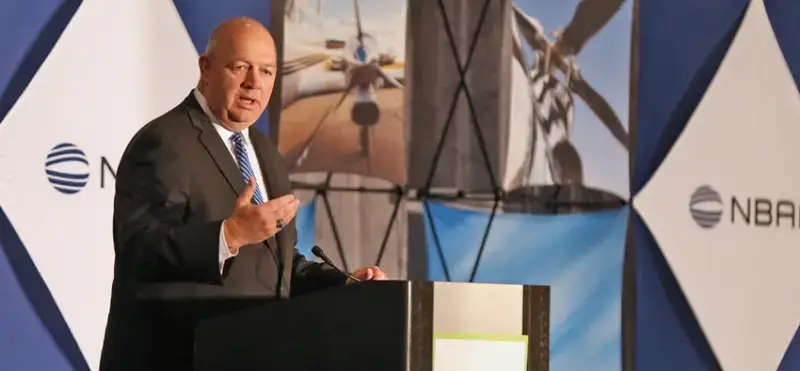
Steve Dickson, seen here speaking at last week’s NBAA event in Las Vegas, testified before the House Transportation Aviation Subcommittee on Thursday. Courtesy: NBAA
After two crashes of Boeing 737 Max aircraft that claimed 346 lives, the Federal Aviation Administration has changed its relationship with Boeing amid the agency’s overhaul of its certification and oversight process, FAA Administrator Steve Dickson told House lawmakers Thursday.
“When I came on board as FAA administrator almost two and half years ago now, the first thing I did was reset the relationship with Boeing,” Dickson said. “I have made it clear to them continually that we will continue to exercise a high level of scrutiny.”
Dickson was called to testify before the House Transportation Aviation Subcommittee to discuss the agency’s progress toward implementing the Aircraft Certification, Safety, and Accountability Act, a 2020 bipartisan aviation reform law resulting from the incidents.
How We Got Here
In October 2018, Lion Air Flight 610 crashed into the Java Sea minutes after departing an airport in Indonesia, killing 189 passengers and crew. An investigation revealed the 737 MAX aircraft, which had been in service two months, incurred flight control problems and instrument and angle of attack (AoA) sensor failures, which were exacerbated by a new maneuvering characteristics augmentation system (MCAS) and pilot response to the malfunctions.
Less than five months later, Ethiopian Airlines Flight 302 crashed under similar circumstances, killing all 157 passengers and crew, eventually prompting regulators around the world, including the FAA, to ground all 737 Max aircraft.
The crashes prompted international civil aviation, FAA and National Transportation Safety Board investigations, as well as an 18-month congressional probe that culminated with the passage of the Aircraft Certification, Safety, and Accountability Act. It was the first major piece of federal legislation in a decade targeting aviation safety.
“The committee’s thorough investigation uncovered flawed management decisions and inadequate organizational structures at Boeing and the FAA that were necessary to confront,” House Transportation Aviation Subcommittee Chair Rick Larsen (D-Washington) said Thursday.
INSIDE THE ACT
The Aircraft Certification, Safety, and Accountability Act aims to establish transparency and accountability in the FAA’s regulation of U.S. aircraft manufacturers through a laundry list of requirements including:
“This legislation should prevent the FAA and Boeing from committing egregious acts, omissions, and errors similar to those that caused those two tragedies and claiming more lives in the future,” House Committee on Transportation and Infrastructure Chair Peter DeFazio (D-Oregon) said in a statement.
In the nearly three years since the Lion Air incident, the FAA has made “significant progress” on addressing findings and recommendations stemming from numerous investigations, Dickson told lawmakers.
“We will continue to prioritize our work to improve aviation safety to make sure this never happens again,” he said.
“We’re committed to the robustness of the certification process, including our oversight of the functions that we delegate to aircraft designers and manufacturers,” Dickson said.
What’s Being Done
The FAA is now delegating fewer responsibilities to manufacturers, and is demanding more transparency from them, Dickson told the House panel. Proposed system changes are evaluated from a whole aircraft perspective, including the human interface elements. The agency is also promoting the use of SMS and created guidance for voluntary SMS programs, he said.
Four aircraft manufacturers have already voluntarily adopted SMS programs, and six others are “in the pipeline,” Dickson said.
Other ongoing FAA initiatives, according to Dickson, include:
- Pursuing rulemaking to standardize guidance for system safety assessments on transport aircraft
- Taking a “fresh look” at human factor assumptions used by the agency for design and certification of transport aircraft including pilot response times
- Expanding data collection and analytics tools in order to more effectively share safety data within the agency and among stakeholders
Call for ‘More Accountability’
Dickson’s testimony comes a week after a federal grand jury indicted former Boeing 737 Max chief technical pilot Mark Forkner, who is accused of scheming to defraud Boeing customers and deceiving the FAA. Last January, Boeing agreed to pay a fine of more than $2.5 billion as part of a deal to resolve criminal prosecution from the U.S. Department of Justice.
More accountability is needed, DeFazio said.
“The fact that one person has been indicted, [and] Boeing was slapped with a fine that’s insignificant in terms of their revenues. I’m concerned that we haven’t seen a major change in the culture there,” DeFazio said of the aircraft manufacturer.
The new aviation safety law, however, ensures continued pressure on the agency from lawmakers going forward.
“It’s a mandate from Congress that the culture at the FAA is going to change,” DeFazio said. “The scrutiny is going to change.”

Sign-up for newsletters & special offers!
Get the latest FLYING stories & special offers delivered directly to your inbox






